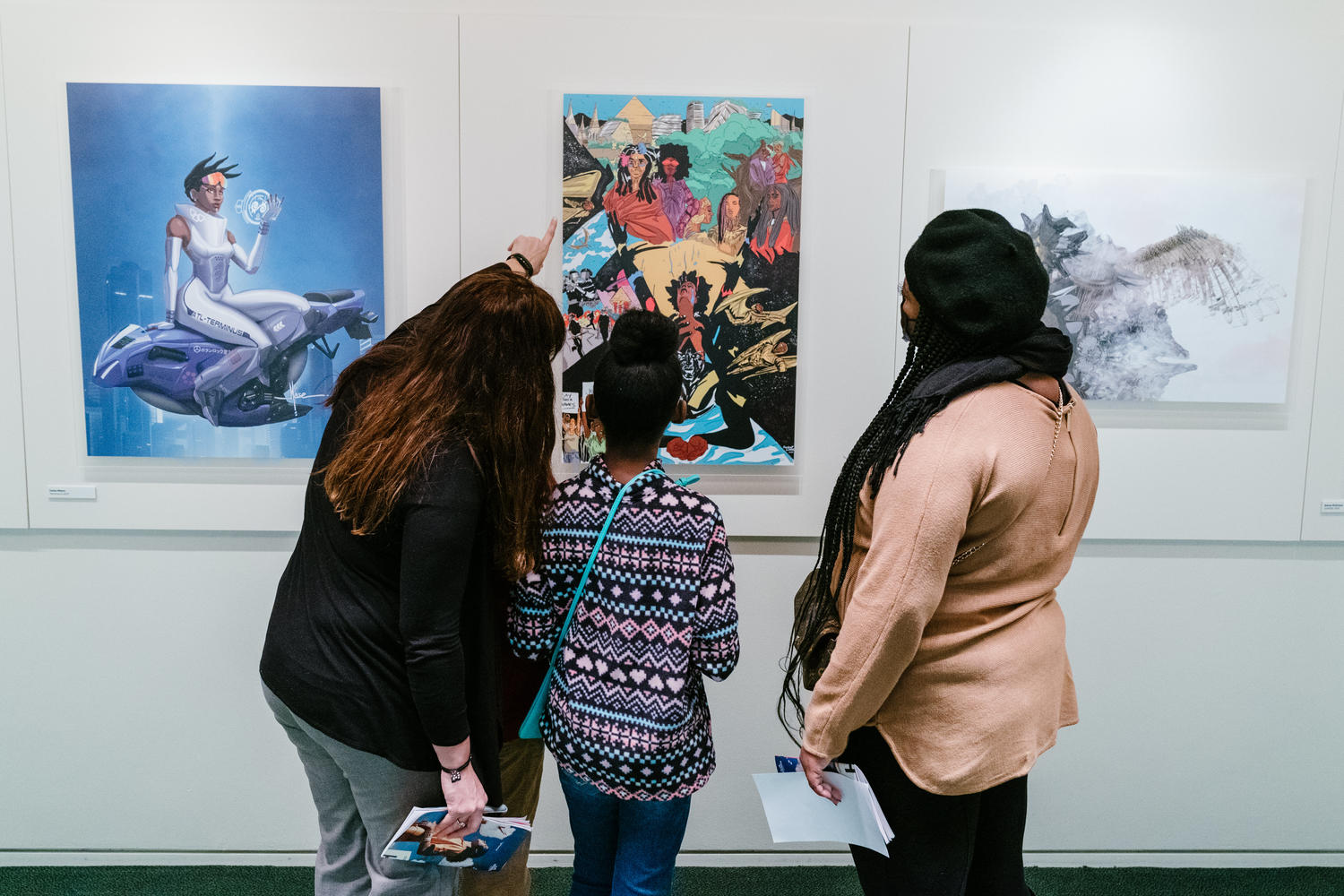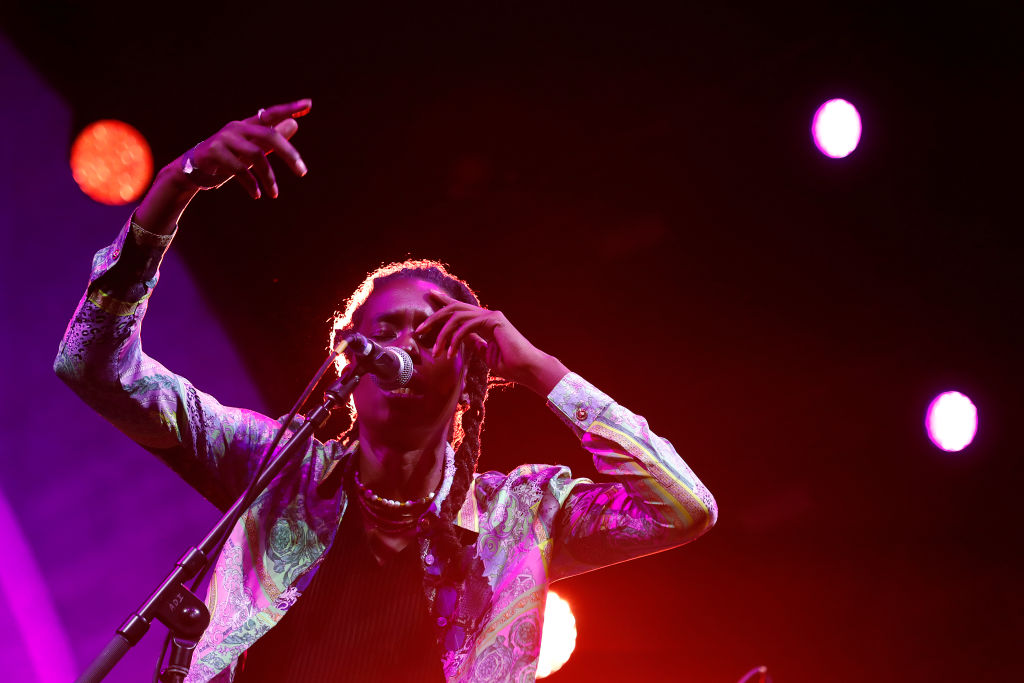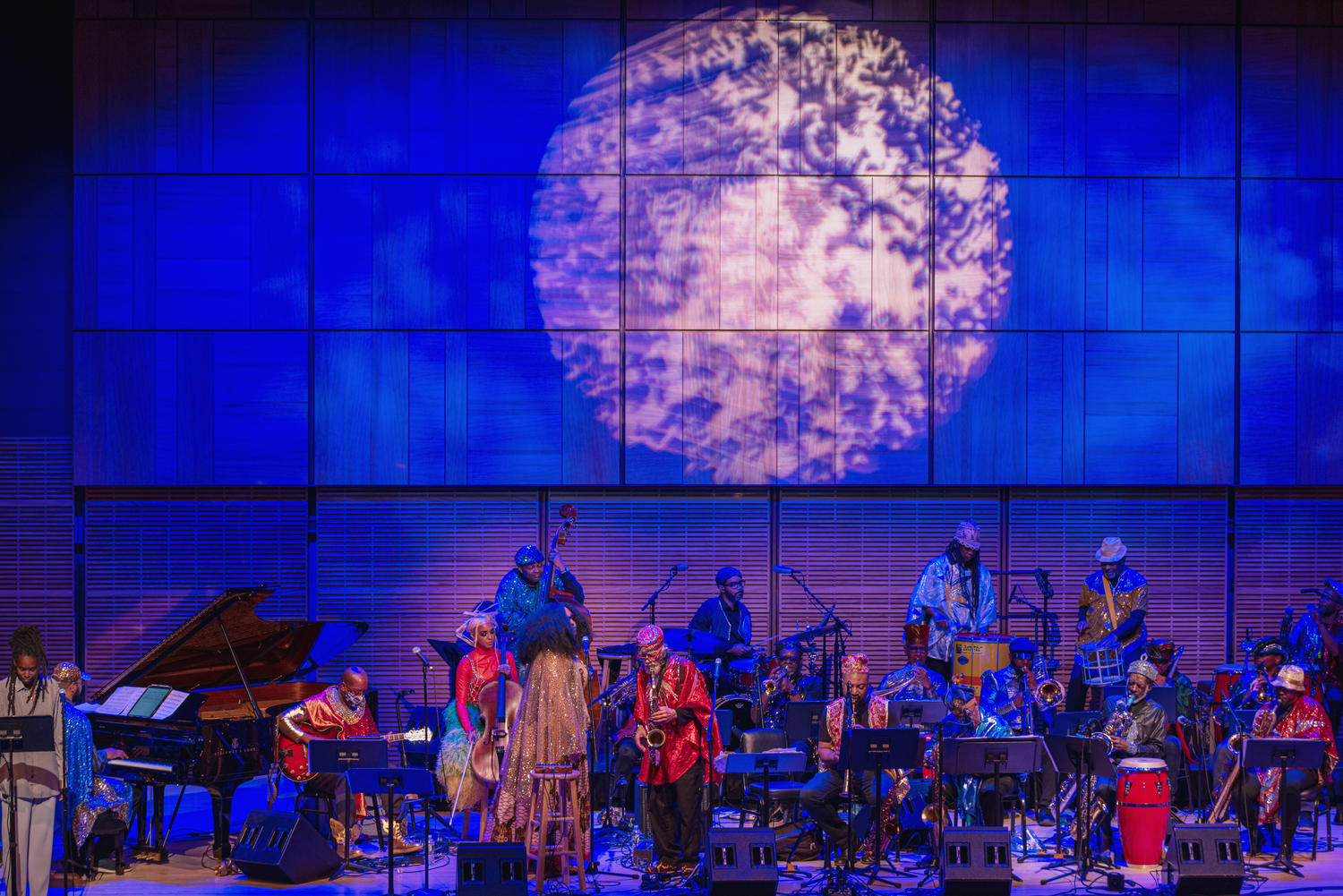
It’s 2072—a year that, like so many others that ultimately mattered, began in its own inconsequential way.
We find ourselves just four years shy of the United States’ third centennial. In the country born from promises of universal freedom but built on stolen land and labor, wealth has continued to be made accessible in patterns that track with race and ethnicity. Back in 2053, half of Black households reached the point of $0 wealth. And, next year, in 2073, half of Latino households will follow.
It is a reality rooted in rollbacks of social-inclusion measures and voting-rights protections—changes that took place even though, more than a decade ago, people of color became America’s supermajority, comprising nearly 60% of the entire population. White America has aged, and has shrunk in number and size, while other fast-growing demographic groups are still not served well by the economy or included without friction in American representative democracy. A substantial portion of the nation’s diverse workforce is poised to be replaced by robots. The small and nearly all-white billionaire class has the resources for joy rides beyond earth’s atmosphere, but hasn’t resolved a litany of major terrestrial social, civil, physical, and economic challenges.
As sea levels in places like Southeast Florida have risen nearly two feet upward on the measuring stick from where they were in 2019, white Americans have remained more likely to own homes and be made whole by insurance and government aid when disasters hit. Some Black Americans have found one potential silver lining in all those disparities: fewer economic and social ties to cut when the rising water forces a move. And, by 2072 they are already migrating—inward and upward. In the United States, it’s Denver; Santa Fe, N.M.; and Cody, Wyo.; cities at altitudes above 4,200 ft. that are filling with the people of color who are America’s first climate refugees. Soon, others will have no choice but to follow.
That’s the way it is. Unless. Unless, that is, we make a different future.
That unless was the most frequently repeated precaution I gleaned when, to mark the end of Black History Month, I asked experts to describe their visions of the Black future.
They are called futurists. Futurism is a multidisciplinary field whose practitioners use data and observation—as well as their imaginations and some might say hopes—to analyze what’s to come. Some of their predictions are a matter of numbers and facts; some are the stuff of sci-fi and philosophy. It’s a field to which government and corporate America has turned to set priorities, identify opportunities, and predict consumer interests.
“There is some stuff that I’m pessimistic about,” says Reynaldo Anderson, an influential Black futurist and Associate Professor of Africology and African American Studies at Temple University, “but I want to be wrong.”
Read more: How Black Lives Matter Is Changing What Students Learn During Black History Month
A brief summary of that stuff: white, minority rule of an allegedly democratic society; “that my people [are] going to drown and starve and be dislocated again and again by climate change”; widening inequality and segregation. “Change is happening faster than people’s ability to adapt to it,” he says. In fact, Anderson, who co-edited the book Afrofuturism 2.0 among others, says, we haven’t even tried. Our ethics and laws already sit decades behind what technology makes possible now.
As I spoke with 10 different futurists, there were, of course, a range of predictions. Those ran from deep concerns about the future of work and even the tax system that supports what we now consider civil society, to theories about the rising economic and cultural influence of China and portions of Africa where, by 2050, 25% of the world’s entire population is expected to live. Others expressed hope and faith in the ability of art to unlock human ingenuity; some were absolutely certain that people—particularly people of African descent—will soon reject systems that do not serve them, slipping the shackles of the oppressive concepts that today seem inescapable.
In fact, that reset may already be starting.
“You have the Great Resignation happening,” Ingrid LaFleur, a curator in Detroit, one-time mayoral candidate, and futurist says about the estimated 47.4 million people in the United States Department of Labor data indicates have resigned from their jobs since January 2021. “There are so many of us—meaning oppressed peoples—who have been given so many examples and have been encouraged to say no, you cannot extract this from me, and I’m excited to see what that means over time.”
In the not-so-distant future it will be normal for Black workers in the United States—the group that, contrary to stereotypes, federal labor data shows is the most likely to hold multiple jobs—to prioritize and elect joy, internal peace and rest, LaFleur thinks. It’s only logical, she says, that workers not well served by the current normal will be more receptive to different ways of working and living.
Another person who sees a wider range of possibilities for Black people in the future is the musician Camae Ayewa, better known as Moor Mother. Hers is one of the first names you’ll encounter if you start looking into ideas associated with the Black Future, such as Afrofuturism and the Black Speculative Arts Movement. They all combine ideas stemming from arts, science, technology and politics. She makes deep, poetry-driven music that’s haunting and rife with references to social conditions, quantum physics, philosophy, history, family, spirituality and health. When we speak by phone, she’s a few days into a three day artists’ residency in Padua, Italy. Soon she’ll leave for Paris for a similar gig. Back in the United States, her home, Moor Mother is also one of the founders of the Black Quantum Futures Collective, a Philadelphia-based group of artists, activists, and others.
“Our main theme of our work is time and temporality,” she explains. “The future is relative. So it’s about having agency in reclaiming that. You know, ‘reclaiming our time’ was a type of meme that went around a couple of years ago, and we really speak to this [idea], not just in the present.”
The collective’s work insists there is a place for Black people in the future. The group shares its ideas at workshops that introduce concepts from quantum physics to participants in low-income communities. Another workshop looks at superhero movies and asks attendees to notice how often characters of color are the ones dying early or outright missing. Another project maps and captures the stories of once-thriving all-Black towns that have disappeared, many of them as a result of racist mob violence. The goal is to help people imagine—and then create—a different kind of future.
“African people, Indigenous people have always thought about the future,” Moor Mother explains. “They looked to the stars. You know, it’s like a tradition that we have been cut off [from].”
Moor Mother’s predictions for the future include the possibility that Black people in the United States and around the world will reconnect with those ideas, exploring the work of African philosophers like the Kenyan scholar John Mbiti and novelists like Octavia Butler. In the future that exists in her mind’s eye, Black people will embrace the idea that time travel happens constantly in subtle ways. Slaves, who had and owned almost nothing, managed to leave small time capsules that in some places have been found beneath their cabins, Moor Mother says. When we grasp bits of our ancestors’ lives, we benefit from the wisdom they worked out. Consider, for example, the Afro pick: a tool created more than 5,000 years ago by people with experience with Black hair, and not coincidentally a symbol of self-acceptance in the present. And in our own work, we will leave messages for those who come after us.

In the future, some of those messages may be in languages that are only just beginning to take shape. Anne Kyoya, a Black futurist in Nairobi and an emerging fellow with the U.S.-based Association of Professional Futurists, says she became a futurist because she sees it as a way for the African continent to focus on building the future that the people want. One of her more interesting predictions involves what’s known as “Sheng”: a hybrid of English and Swahili that has emerged among young people who need a common tongue after coming to Nairobi from rural areas where dozens of unofficial languages and dialects are spoken. Once regarded simply as slang, Sheng is today the language of survival and street commerce, of friendly exchanges and of those who are cool, Kyoya tells me when we talk over Zoom from her home outside the capitol. Kyoya predicts that in 20 years Sheng will be what some consider their first language or mother tongue, and will take its place in workplaces and organizations.
And it’s not just language that Africa’s young population will influence. More and more young people have studied or lived abroad, she says, and are bringing some of that back to their home countries. Already, some of the people who are most influential around the continent do not live in Africa at all, from Tanzanian millionaire businessman and environmentalist Patrick Ngowi to South African comedian Trevor Noah. Now the government structures just have to catch up—for example, reshaping tax codes to better accommodate the informal and gig work that supports many young people.
“What we are seeing is …what we call a global mindset,” she says. “Someone with a global mindset or a global entrepreneur is one who identifies problems that impact on society and then identifies the right partnerships to be able to attack that problem, irrespective of where they are stepping [live].”
When I ask Kyoya if it seems that the kind of economic and social trends she’s observing will, over the next 50 years, bring more frequent or deeper connections between people of the African diaspora scattered around the world, she laughs. Technology, in a way, makes the answer obvious. Kyoya quickly points out that she and I have never met in person but are speaking via Zoom, smiling at one another, taking in some of what there is to be known about one another.
Particularly now that the pandemic has untethered many people from their offices, both Kyoya and LeFleur see a coming world in which those realities, those cultural connections, position many Black people of various origins to engage in all kinds of joint social and economic projects. “We can not walk backwards to our future,” Kyoya says.
But even among futurists who disagree about the details, there’s a commonly held belief that if conditions do not change, the Black future, and thus the American future, may well have a bit of a dystopian movie feel. With one big change: while sci-fi has had a tendency to display a future world in which Black people either don’t exist or race itself ceases to have meaning, there are, to be very clear, Black people in the future.
Though, racial classifications in the United States have and are expected to evolve, the Black population in the United States—native and foreign-born—is expected to grow from about 49 million people, or 13.3% of the population in 2030, to 60.6 million people, or 15% of the population by 2060. And overseas, as much of the population in the West and China ages, Africa will be brimming with young people, and will see much of the world’s net population growth. In 2100, anywhere from 33% to 40% of the world’s entire population will be African—including an already burgeoning Afro-Chinese population that Yul Anderson, president of the African American Future Society, believes will help bring Chinese wealth to African nations.
But, Anderson says, anyone who reads that and assumes that a more multi-racial, less white, world will mean that racial inequality or discrimination will somehow cease to exist isn’t paying attention to the past, or for that matter, the present.
For example, one major international consulting firm is projecting that by 2030, automation will hit Black and Latino Americans harder than other groups because of the often low-wage industries in which those groups often work now. And thus far, the only “solutions” Anderson has heard many people talking about for the estimated 40% of Black workers expected to be displaced —that someone has to do the manual labor of maintaining all those robots, for example—do not sound serious or at all fresh, he says.
“If you are marginalized now, the potential is you are going to be marginalized in the future,” he says.
Read more: This Is How February Became Black History Month
This month, Anderson, who is Black and based in Atlanta—and whose claim to fame in the world of futurists includes a February 2020 prediction that conditions were ripe for mass social unrest in the United States—helped to organize The Future Black America conference for The International Monetary Fund and United Nations Educational, Scientific and Cultural Organization, better known as the IMF and UNESCO. He’s also working with Reynaldo Anderson, no relation, to help explore the possibility of creating a futurist certificate that schools could offer as an add-on to other degrees..
“If you don’t have a diverse group of people participating in the future direction of the planet then it just self-prophecies white supremacy,” says Yul Anderson. “Those in power predict and manipulate futures that keep them in power. So if you don’t get out there and say, ‘yo, hey, you got to make sure I’m in the future,’ then you are not going to be involved.”
The thing that gives Anderson some hope is the growing amount of power—to highlight injustices, to share ideas with people worldwide, to foment protest—that technology puts in the hands of many Black individuals. The events of recent years, following what Anderson calls the “Black Spring” of 2020, have both bolstered that idea and laid bare some of conditions that are necessary to see a better future come to fruition.
“I only hope that we can pivot as a people fast enough to change the trajectory of the negative reporting [forecasts],” he says. “It’s very difficult to talk about the future when you have a knee on your neck. The only thing you are thinking about is immediate relief.”
Anderson is less than optimistic elected officials—including the Black ones—are focused on the right fights to deliver a better future. But out of the UNESCO conference, work has begun to create a 200- to 300-member commission on the Study of the Future of Black America. The goal: produce reports that forecast the Black Future, spread the word about alternatives and what would be required to wind up there. The hope: that those ideas might wind their way into the work of elected officials or organizations that can help turn them into a reality.

Black people around the world, given their struggles in the present, have a particular need to develop and “flex” their foresight muscles, Anne Kyoya told me when we spoke. That’s an idea very much on my mind when I walk into Carnegie Hall in late February for a Sun Ra Arkestra concert, part of an Afrofuturism festival. Reynaldo Anderson, the Temple professor, is a member of the Curatorial Council that helped plan the event.
I’m here because the late Herman Blount, better known as Sun Ra, a mystical, avant-garde Black American musician and poet who made racial metaphor of extraterrestrial origin stories, remains a guidestar in this realm, even nearly 30 years after his death. His group’s art is a core part of the soundtrack preferred by many who work at, enjoy or try to think hard about the Black Future.
Inside, the audience is a little less than half Black. And among them are an unusual number of gray-haired Black men in black berets. Band leader Marshall Allen, 97, plays a saxophone solo like he has the lungs of a man a third his age. Behind him is the nearly 30-piece Arkestra—dressed in sequin-covered capes, baseball caps, Breton hats, Fez, and Kufi—and two singers with voices that make this fact-focused reporter feel, in a word, transported.
The songs are jazzy, some more improvisational than others. But the lyrics, the sounds, the on-stage caped dancer, evoke a kind of feeling of time travel—backwards and forwards. A white woman in the audience pulls a tambourine from her purse. Then, Moor Mother comes to the front of the stage and speaks a poem over the Arkestra’s sounds.
“I was never here,” she says slowly, speaking of the past, the present and the Black Future. “Just a continual echo in a strange land. I was a quantum event on this planet, desolate and dangerous…..From 1619…whose timeline? Whose life is this?”
More Must-Reads from TIME
- Why Biden Dropped Out
- Ukraine’s Plan to Survive Trump
- The Rise of a New Kind of Parenting Guru
- The Chaos and Commotion of the RNC in Photos
- Why We All Have a Stake in Twisters’ Success
- 8 Eating Habits That Actually Improve Your Sleep
- Welcome to the Noah Lyles Olympics
- Get Our Paris Olympics Newsletter in Your Inbox
Contact us at letters@time.com